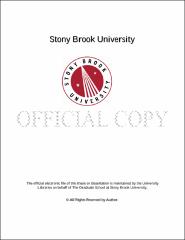| dc.identifier.uri | http://hdl.handle.net/11401/77401 | |
| dc.description.sponsorship | This work is sponsored by the Stony Brook University Graduate School in compliance with the requirements for completion of degree. | en_US |
| dc.format | Monograph | |
| dc.format.medium | Electronic Resource | en_US |
| dc.language.iso | en_US | |
| dc.publisher | The Graduate School, Stony Brook University: Stony Brook, NY. | |
| dc.type | Dissertation | |
| dcterms.abstract | The tropical Andes, the richest region in the world in terms of biodiversity, faces widespread anthropogenic alteration of habitats. As a result, this region harbors one of the highest concentrations of threatened species worldwide. While there has been extensive research on the effects of habitat alteration on biodiversity, studies often focus on one level of ecological organization; however all levels are inherently linked. I investigated the influence of habitat alteration on biodiversity by studying hummingbird populations, the structure of hummingbird assemblages, and hummingbird - plant interactions in habitats with different land-use types that are the result of different human-induced alteration in the southern Andes of Ecuador. At the population level, I evaluated habitat specific demographic parameters of three hummingbird species, Metallura tyrianthina, Eriocnemis luciani, and Coeligena iris. Population growth rates of these species indicated that M. tyrianthina and E. luciani populations can likely persist in some altered habitat types; however, C. iris populations could be negatively affected by habitat alteration. At the assemblage level, I explored how landscape and local habitat characteristics influenced functional and taxonomic diversity of hummingbirds. Althought there was little taxonomic change across landscapes with different types of alteration, functional diversity of hummingbirds decreased in more altered landscapes. At the level of hummingbird - plant interactions, I assessed variation in hummingbird's diet specialization using a species interaction network approach, and explored how changes in specialization could be mediated by evolutionary factors (i.e., morphological traits) and ecological factors (i.e., resource availability). Results indicated that factors operating over short ecological time scales (i.e., variation in resource availability) may produce variation in the level of specialization of hummingbirds; however, I also found that the hummingbirds' specialization was determined by morphological features (i.e., bill length) whose change occurs through evolutionary time. Hummingbirds were less specialized in more altered habitat types. Overall my result showed that some aspects of hummingbird's biodiversity can be negatively affected by habitat alteration, which could have negative repercussion for biodiversity and ecosystem functioning in the tropical Andes. Moreover, this dissertation demonstrates that studying the effects of anthropogenic habitat alterations requires exploration of multiple facets of biodiversity, because each level of ecological organization contributes different insights about the on-going effects of human induced alteration. | |
| dcterms.available | 2017-09-20T16:52:38Z | |
| dcterms.contributor | Akcakaya, Resit | en_US |
| dcterms.contributor | Graham, Catherine H | en_US |
| dcterms.contributor | Padilla, Dianna | en_US |
| dcterms.contributor | Latta, Steven. | en_US |
| dcterms.creator | Tinoco, Boris A. | |
| dcterms.dateAccepted | 2017-09-20T16:52:38Z | |
| dcterms.dateSubmitted | 2017-09-20T16:52:38Z | |
| dcterms.description | Department of Ecology and Evolution. | en_US |
| dcterms.extent | 125 pg. | en_US |
| dcterms.format | Monograph | |
| dcterms.format | Application/PDF | en_US |
| dcterms.identifier | http://hdl.handle.net/11401/77401 | |
| dcterms.issued | 2015-08-01 | |
| dcterms.language | en_US | |
| dcterms.provenance | Made available in DSpace on 2017-09-20T16:52:38Z (GMT). No. of bitstreams: 1
Tinoco_grad.sunysb_0771E_11875.pdf: 3226000 bytes, checksum: 5ee25a05f775a30822d89eb77a839ad2 (MD5)
Previous issue date: 2014 | en |
| dcterms.publisher | The Graduate School, Stony Brook University: Stony Brook, NY. | |
| dcterms.subject | Andes, demography, Disturbance, Ecuador, landscape, networks | |
| dcterms.subject | Ecology | |
| dcterms.title | Undestanding the influence of habitat alteration on hummingbird species using a multi-level analysis approach | |
| dcterms.type | Dissertation | |

